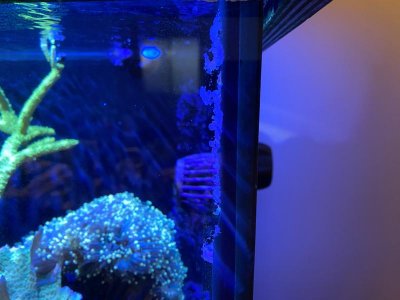reefdiculous
Member
Hey Everyone,
Just a quick question. So, yesterday I just noticed one of my silicone seams on my 90 gallon Marineland tank looked chipped or eaten away. No other seams look like this, just what you see in the attached picture. The tank is only about 6 years old (had it since new) and I am always very very careful not to nick the seams when I scrape algae. What could be happening?
Some thoughts come to mind:
1. Maybe a snail going after the Coralline algae is also taking a little silicone?
2. Maybe a fish is nipping at it?
3. Maybe natural aging?
4. Maybe the Coralline algae is causing it to chip somehow?
Does this look serious to you seasoned reef keepers? What should I do? Just keep an eye on it to see if it gets worse? Reseal right away?
<a href="https://ibb.co/WnDBpG0"><img src="https://i.ibb.co/ZdHc1GS/silicone-seam.jpg" alt="silicone-seam" border="0" /></a>
Just a quick question. So, yesterday I just noticed one of my silicone seams on my 90 gallon Marineland tank looked chipped or eaten away. No other seams look like this, just what you see in the attached picture. The tank is only about 6 years old (had it since new) and I am always very very careful not to nick the seams when I scrape algae. What could be happening?
Some thoughts come to mind:
1. Maybe a snail going after the Coralline algae is also taking a little silicone?
2. Maybe a fish is nipping at it?
3. Maybe natural aging?
4. Maybe the Coralline algae is causing it to chip somehow?
Does this look serious to you seasoned reef keepers? What should I do? Just keep an eye on it to see if it gets worse? Reseal right away?
<a href="https://ibb.co/WnDBpG0"><img src="https://i.ibb.co/ZdHc1GS/silicone-seam.jpg" alt="silicone-seam" border="0" /></a>

